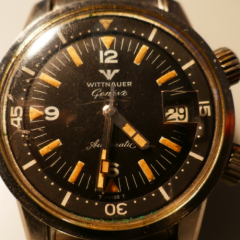A Tool For Balance Screw Adjustments
-
Similar Content
-
Recently Browsing
- No registered users viewing this page.
-
Topics
-
Posts
-
These types of hairsprings become weak with age and very fragile. Which I expect it is that giving you trouble, and that wheel is not the correct one, if it were not bent I don't think the movement would run as the teeth are not the correct height. The problem you have is price which depends on you. It can be repaired but is it worth it to you, because there is little value in the clock. A wheel can be made and hairspring replaced. Or hang on to it and keep looking on ebay which is your best bet for replacement parts or even a complete movement but it will be like finding a needle in a haystack.
-
I did that also for a few movements - well, mainly in/around the train jewels. I made big efforts to epilame the mainplate WITHOUT getting Epilame into the Pallet fork jewels (where it's not supposed to be, right?). I made litte barriers with Rodico around that jewel and used drops from a syringe to apply on the rest. However, I've now stopped doing this. For three reasons: 1. It's a hassle and consumes more of this liquid gold. 2. I didn't see the need when using HP1000/HP1300 lubricants and grease for most part. The two places where I'd use 9010 (i.e. escape wheel and balance) receive Epilame in specific places... or the cap-jewel-setting of the balance suspends the oil sufficiently be capillary action (see my "conflict" about using Epilame on the balance jewels). 3. Lastly, and here I really wonder about yours and others' experiences: I felt that applying Epliame to the train jewels left them looking hazy (borderline dirty) compared to the (painstakingly achieved) sparkly clean results of my cleaning process. I just can't help but think that the Epilame residuals would mix with the oil and cause more friction/wear. I don't know. simple: it'll stay there. It won't move any further. That's exactly what is happening if you epilame a cap stone. You end up placing the 9010 right on top of the epilame and the oil will sit nicely on that spot.
-
By Neverenoughwatches · Posted
There are some parts on Ebay for the seiko 6020A, it may just be a waiting game for someone to strip one down, NOS will be more scarce . K would strip your movement down to the module then start looking at other seiko movement to see if that coil is used, then seek out a seiko part dealer. Also Retrowatches youtube owner Mike may give you some advice try him on his site . He also hangs around amateur watchmaking groups. -
I would agree, in order to work harden something you need to exceed it's yield strength when it moves from the elastic zone to the plastic zone and you get permanent deformation and work hardening which is fairly close to its failure point, relatively speaking and dependent on the material/alloy of course. In theory you can load something constantly within its elastic range and not suffer work hardening issues.
-
Probably easier to get a complete new movement - but CousinsUK list it as discontinued. Maybe someone on here knows a substitute movement ?
-






.thumb.jpg.cb17a66989f1e796fd4217db2e9ca9df.jpg)


Recommended Posts
Join the conversation
You can post now and register later. If you have an account, sign in now to post with your account.
Note: Your post will require moderator approval before it will be visible.